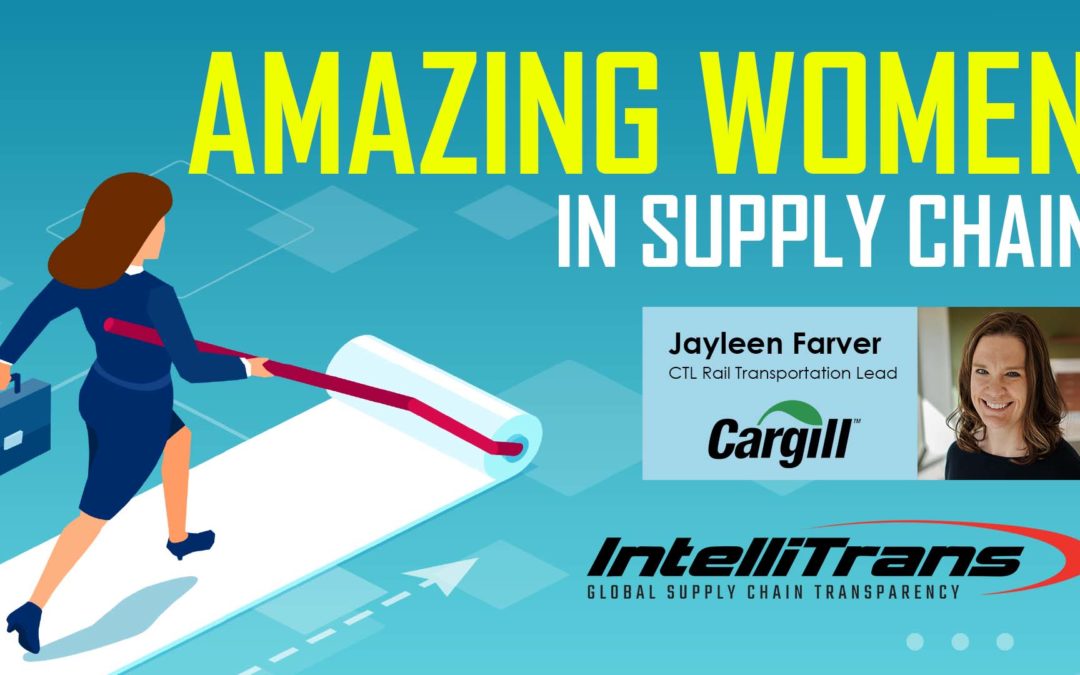Between managing a team and a large rail car fleet, Jayleen Farver of Cargill knows that success in supply chain means taking risks, sticking your neck out, and grabbing new opportunities.

As CTL Rail Transportation Lead for Cargill, Jayleen Farver manages a 12-person team that has oversight of the company’s railcar fleets. Working together, they track railcar shipments, manage escalations, and plan Cargill’s pipelines to ensure an overall freight balance. They also manage the movement of railcars in and out of shop locations (i.e., for storage, cleaning, repair, etc.).
In her role, Farver also keeps close tabs on how the current freight environment and routine railroad service issues may impact Cargill. “I’m up early in the morning, checking to make sure that the cars arrived as scheduled the night before for locations we had escalated the day prior given their criticality,” she says. “That’s the kind of stuff that keeps me up at night, along with remaining cognizant of how any potential delays or interruptions will impact our businesses and team.”
Farver also deals with a constant flow of policy changes and new charges being enforced by the railroads. For example, the railroads all have different rules relating to what is or isn’t chargeable when it comes to empty railcars. “This adds some additional pressure in terms of keeping our costs down,” she explains, “as we try to contain costs the best we can while still assuring we are balancing our fleets and also keeping up with the constant policy changes.”
Putting Technology to Work
Farver launched her supply chain career in 2004, when she took a position working for a local trucking company. She worked in a customer service role there for about three years and then joined Cargill’s rail team about 14 years ago. She’s held multiple different roles in supply chain since that time, most of them focused on rail.
Today, Farver’s team is broken down by specific business and product lines. She provides support to those team members, manages a high volume of escalations, handles strategy work, and helps Cargill plan for the future. Farver is also helping the company adopt and use technology that facilitates its supply chain management activities.
“IntelliTrans’ Global Visibility Platform (GVP) is a big part of how we’re addressing it,” she says. “We utilize it to track our yard numbers, check to see if we’re over the allocation that the railroads have implemented, and then call that out before the railroads do.” Farver’s team has also used GVP to address railroads’ policy changes regarding what is or isn’t chargeable.
“We’ve added comments into our GVP tool on those trips, so we have additional visibility to why a move was chargeable and to see what could be done differently to improve those costs,” says Farver, who has also been working with Cargill’s Class I carriers on application program interface (API) services. “I know GVP is going down this road as well, and we’re hoping to see some additional automation in that area, given some of the latest technological advancements.”
Supply Chain Visibility is Vital
Providing supply chain visibility to customers and business clients is a priority for Cargill, which folds as much automation as possible into this process. Using GVP, for example, Farver’s team produces hundreds of different “snapshot reports” on a daily basis for its external and internal customers. “It gives them a pipeline of where inventory is at,” says Farver, “and has been a great visibility tool for our customers.”
The company also uses “shop and storage dashboards,” which examine trends and strategies related to the storage and shopping of railcars. “We also utilize the cycle times, and watch our transit and dwell times to assist with fleet right-sizing,” Farver explains. “We’re continually looking for opportunities to make improvements on the dwell side.”
Looking ahead, Farver expects supply chains as a whole to continue down the path to becoming even more automated and data-centric. “I’ve been hearing so much more about this over the last year or two, and I do think that’s going to continue,” says Farver. “As we move further away from doing manual tasks and using spreadsheets, the future is going to be focused on automation and data.”
Stick Your Neck Out and Take Some Risks
When this Amazing Woman in Supply Chain joined the Cargill team 14 years ago, college degrees in supply chain had yet to come of age and there were really no “courses” that you could take to learn the ropes in this industry. That meant a lot of trial and error and “learning on the job” for new entrants into the supply chain field.
Fast-forward to 2021 and Farver says she’s now seeing many new women coming onboard armed with college degrees, internship experience, and skillsets that help them hit the ground running quickly. And knowing that supply chain isn’t a 9-5 job, Farver is also happy to see more flexible work arrangements becoming available.
To women who are either making their way into their first supply chain jobs or looking to advance in their careers, Farver says her best piece of advice is to take a few risks along the way because you never know where they may lead you. “Women tend to not apply for roles when they can’t do a majority of what’s on the job description, but I don’t think we should be cutting ourselves short like that,” she recommends. “Instead, stick your neck out and take those risks.”

